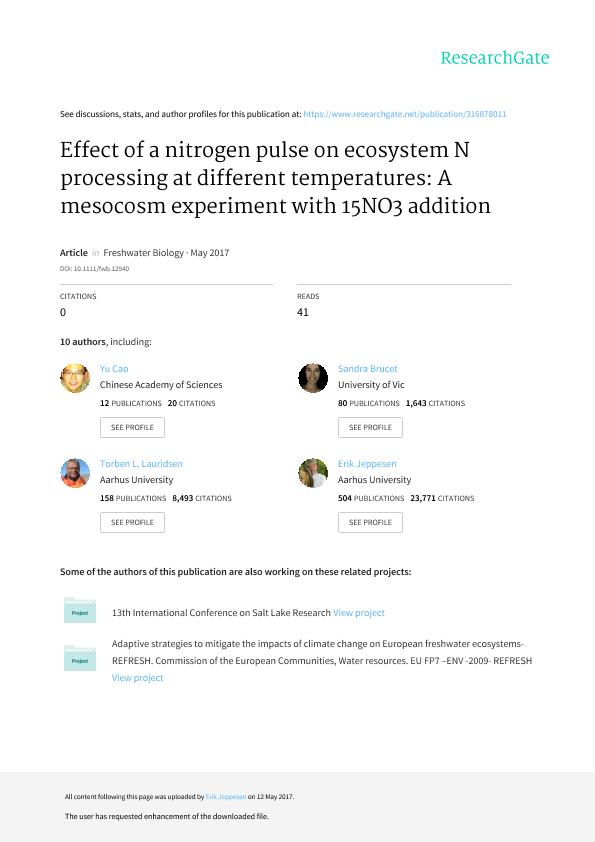Mostrar el registro sencillo del ítem
dc.contributor.author
Olsen, Saara
dc.contributor.author
Cao, Yu
dc.contributor.author
Gutierrez, Marìa Florencia

dc.contributor.author
Brucet, Sandra
dc.contributor.author
Landkildehus, Frank
dc.contributor.author
Lauridsen, Torben L.
dc.contributor.author
Davidson, Thomas A.
dc.contributor.author
Søndergaard, Martin
dc.contributor.author
Jeppesen, Erik
dc.contributor.author
Risgaard-Petersen, Nils
dc.date.available
2018-09-17T14:45:25Z
dc.date.issued
2017-07
dc.identifier.citation
Olsen, Saara; Cao, Yu; Gutierrez, Marìa Florencia; Brucet, Sandra; Landkildehus, Frank; et al.; Effect of a nitrogen pulse on ecosystem N processing at different temperatures: A mesocosm experiment with 15NO3 − addition; Wiley Blackwell Publishing, Inc; Freshwater Biology (print); 62; 7; 7-2017; 1232-1243
dc.identifier.issn
0046-5070
dc.identifier.uri
http://hdl.handle.net/11336/59847
dc.description.abstract
Shallow lakes may play an important role for the nitrogen (N) balance in drainage basins by processing, transferring and retaining N inputs. An increase in the frequency of storm-induced short-term N pulses and increased water temperatures are both likely outcomes of climate change, potentially affecting the N processing in lakes. An experiment with a K15NO3 − pulse addition (increase in NO3 − concentration from c. 0.1 to 2 mg/L) was carried out in 12 mesocosms with relatively low (applies to Danish lakes) total N (TN) and total phosphorus (TP) concentrations (c. 0.3 mg N L−1 and 0.04 mg P L−1) to assess the effects of an N pulse on N processing and storage in shallow lake ecosystems. The mesocosms have a hydraulic retention time of approximately two and a half months, and at the time of the experiment, they had been adapted to contrasting temperatures for a period of 10 years: ambient, T3 (heating according to the Intergovernmental Panel on Climate Change 2007 A2 scenario, +3.7–4.5°C, depending on season) and T5 (heating with A2 + 50%, +4.9–6.6°C). Macrophytes and filamentous algae retained up to 40% and 30% of the added 15N, respectively, reflecting their high biomass in the mesocosms. Macrophytes and filamentous algae constituted between 70% and 80% of the biomass of all primary producers during the experiment in the T3 and ambient treatments and between 20% and 40% in T5. By comparison, less than 1% of the added 15N diffused to the sediment and less than 5% was lost to the atmosphere as N2 gas. Snails represented the long-term storage of 15N, retaining up to 6% of the tracer and with detectable enrichment 100 days after tracer addition. We found no significant differences among the temperature treatments in the 15N turnover after pulse dosing. However, a larger percentage of 15N was stored in macrophytes in the ambient and T3 mesocosms, reflecting higher biomasses than in T5 where filamentous algae were more abundant. Macrophytes and filamentous algae rather than temperature were therefore key controllers of N processing during the summer N pulse in these shallow, relatively low TP lakes.
dc.format
application/pdf
dc.language.iso
eng
dc.publisher
Wiley Blackwell Publishing, Inc

dc.rights
info:eu-repo/semantics/openAccess
dc.rights.uri
https://creativecommons.org/licenses/by-nc-sa/2.5/ar/
dc.subject
15n Addition
dc.subject
Mesocosm
dc.subject
Nitrogen Pulses
dc.subject
Primary Production
dc.subject
Temperature
dc.subject.classification
Meteorología y Ciencias Atmosféricas

dc.subject.classification
Ciencias de la Tierra y relacionadas con el Medio Ambiente

dc.subject.classification
CIENCIAS NATURALES Y EXACTAS

dc.title
Effect of a nitrogen pulse on ecosystem N processing at different temperatures: A mesocosm experiment with 15NO3 − addition
dc.type
info:eu-repo/semantics/article
dc.type
info:ar-repo/semantics/artículo
dc.type
info:eu-repo/semantics/publishedVersion
dc.date.updated
2018-09-14T13:21:59Z
dc.journal.volume
62
dc.journal.number
7
dc.journal.pagination
1232-1243
dc.journal.pais
Reino Unido

dc.journal.ciudad
Londres
dc.description.fil
Fil: Olsen, Saara. Sino-danish Centre For Education And Research (sdc); China. University Aarhus; Dinamarca
dc.description.fil
Fil: Cao, Yu. Chinese Academy of Sciences; República de China
dc.description.fil
Fil: Gutierrez, Marìa Florencia. Consejo Nacional de Investigaciones Científicas y Técnicas. Centro Científico Tecnológico Conicet - Santa Fe. Instituto Nacional de Limnología. Universidad Nacional del Litoral. Instituto Nacional de Limnología; Argentina
dc.description.fil
Fil: Brucet, Sandra. University Aarhus; Dinamarca. Institucio Catalana de Recerca I Estudis Avancats; . Universitat de Vic;
dc.description.fil
Fil: Landkildehus, Frank. University Aarhus; Dinamarca
dc.description.fil
Fil: Lauridsen, Torben L.. University Aarhus; Dinamarca. Sino-danish Centre For Education And Research (sdc); China
dc.description.fil
Fil: Davidson, Thomas A.. University Aarhus; Dinamarca
dc.description.fil
Fil: Søndergaard, Martin. University Aarhus; Dinamarca. Sino-danish Centre For Education And Research (sdc); China
dc.description.fil
Fil: Jeppesen, Erik. University Aarhus; Dinamarca. Sino-danish Centre For Education And Research (sdc); China
dc.description.fil
Fil: Risgaard-Petersen, Nils. University Aarhus; Dinamarca
dc.journal.title
Freshwater Biology (print)

dc.relation.alternativeid
info:eu-repo/semantics/altIdentifier/url/http://onlinelibrary.wiley.com/doi/10.1111/fwb.12940/full
dc.relation.alternativeid
info:eu-repo/semantics/altIdentifier/doi/http://dx.doi.org/10.1111/fwb.12940
Archivos asociados
